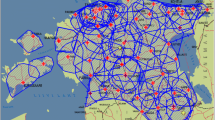Abstract
Background
Trauma in the elderly (≥55 years) accounts for a significant proportion of admissions to trauma centers. Our understanding of the epidemiology and outcomes associated with penetrating injury in this age segment of the population, however, is severely limited. The aim of the present study therefore was to investigate the incidence and type of injuries sustained by elderly patients from firearms and the impact of age on outcomes.
Methods
This was a 5-year National Trauma Databank (NTDB) study. Injury demographics, mortality rates, and lengths of stay in the Intensive Care Unit (ICU) and the hospital were analyzed. Elderly patients ≥55 years old were assigned to one of three categorical strata: 55–64 years old, 65–74 years old, and ≥75 years old.
Results
During the study period, 98,242 patients were admitted for firearm-related injuries, and 3,190 (3.2%) of them were ≥55 years old. Within the elderly age segment of the population, 1,676 patients (52.5%) were 55–64 years of age, 727 (22.8%) were 65–74 years of age, and 787 (24.7%) were ≥75 years old. The incidence of severe trauma [Injury Severity Score (ISS) ≥ 16] in the elderly age strata was 43.3, 46.8, and 57.6%, respectively (p < 0.001). Patients ≥75 years old were significantly more likely than patients 55–74 years old to suffer self-inflicted injuries. The most commonly encountered injury in elderly patients was gunshot wounds to the head, which increased in a stepwise fashion with advancing age (25.8, 31.6, and 39.4% respectively; p < 0.001). The crude mortality rate in all patients sustaining gunshot wounds increased progressively with age. Within the elderly age segment, mortality ranged from 28.5% in the age stratum 55–64 years, to 55.4% in the stratum ≥75 years (adjusted p < 0.001). Intensive care unit and hospital length of stay increased with advancing age but peaked and remained stable among the elderly age groups. An admission Glasgow Coma Score (GCS) ≤ 8, an ISS ≥ 16, hypotension on admission, age, self-inflicted injury, and injury sustained by assault were factors independently associated with death in patients ≥55 years.
Conclusions
Injury from firearms is not uncommon in the elderly patient population and is primarily a result of self-inflicted gunshot wounds to the head. These patients sustain a high burden of injury and a high rate of mortality, which increases with advancing age.




Similar content being viewed by others
References
United States Census Bureau (2008) Age groups and sex 2008. United States Census Bureau, Washington, DC
Bergen G, Chen LH, Warner M et al (2008) Injury in the United States: 2007, Chartbook. National Center for Health Statistics, Hyattsville
Roth BJ, Velmahos GC, Oder DB et al (2001) Penetrating trauma in patients older than 55 years: a case–control study. Injury 32:551–554
Nagy KK, Smith RF, Roberts RR et al (2000) Prognosis of penetrating trauma in elderly patients: a comparison with younger patients. J Trauma 49:190–193 discussion 193–194
Asensio JA, Trunkey DD (eds) (2008) Current therapy of trauma and surgical critical care. Mosby Elsevier, Philadelphia
Centers for Disease Control and Prevention (2008) National center for injury prevention and control. Suicide. Facts at a glance. Summer, Atlanta, GA
Demetriades D, Murray J, Sinz B et al (1998) Epidemiology of major trauma and trauma deaths in Los Angeles County. J Am Coll Surg 187:373–383
Taylor MD, Tracy JK, Meyer W et al (2002) Trauma in the elderly: intensive care unit resource use and outcome. J Trauma 53:407–414
Kuhne CA, Ruchholtz S, Kaiser GM et al (2005) Mortality in severely injured elderly trauma patients—when does age become a risk factor? World J Surg 29:1476–1482
Perdue PW, Watts DD, Kaufmann CR et al (1998) Differences in mortality between elderly and younger adult trauma patients: geriatric status increases risk of delayed death. J Trauma 45:805–810
Ottochian M, Salim A, DuBose J et al (2009) Does age matter? The relationship between age and mortality in penetrating trauma. Injury 40:354–357
Demetriades D, Karaiskakis M, Velmahos G et al (2002) Effect on outcome of early intensive management of geriatric trauma patients. Br J Surg 89:1319–1322
Demetriades D, Sava J, Alo K et al (2001) Old age as a criterion for trauma team activation. J Trauma 51:754–756 discussion 756–757
Scalea TM, Simon HM, Duncan AO et al (1990) Geriatric blunt multiple trauma: improved survival with early invasive monitoring. J Trauma 30:129–134 discussion 134–136
McGwin G Jr, Melton SM, May AK et al (2000) Long-term survival in the elderly after trauma. J Trauma 49:470–476
Inaba K, Goecke M, Sharkey P et al (2003) Long-term outcomes after injury in the elderly. J Trauma 54:486–491
Wagner AK, Sasser HC, Hammond FM et al (2000) Intentional traumatic brain injury: epidemiology, risk factors, and associations with injury severity and mortality. J Trauma 49:404–410
Bennett KM, Vaslef SN, Shapiro ML et al (2009) Does intent matter? The medical and societal burden of self-inflicted injury. J Trauma 67:841–847
Author information
Authors and Affiliations
Corresponding author
Rights and permissions
About this article
Cite this article
Lustenberger, T., Inaba, K., Schnüriger, B. et al. Gunshot Injuries in the Elderly: Patterns and Outcomes. A National Trauma Databank Analysis. World J Surg 35, 528–534 (2011). https://doi.org/10.1007/s00268-010-0920-7
Published:
Issue Date:
DOI: https://doi.org/10.1007/s00268-010-0920-7




